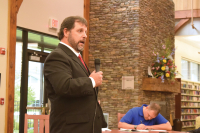Emergency management plan helps when disaster hits
 By Mark Swanger • Guest Columnist
By Mark Swanger • Guest Columnist
Regardless of their magnitude, all disasters — natural or man-made — are local events and require an immediate, coordinated response from local government to protect public health, safety and welfare.
This function is called Emergency Management, and, in the aftermath of national tragedies such as 9/11 and Hurricane Katrina, not to mention incidents like our own two 500-year floods in September 2004, many local governments have adopted ordinances to allow for a better, quicker response to disasters. These Emergency Management ordinances, which are heavily regulated through state and federal laws, give local governments the authority to quickly mobilize the resources needed to protect our citizens when the unexpected occurs.
The North Carolina General Assembly has affirmed that county commissions are responsible for the provision of emergency management within the geographic boundaries of each county (NCGS 166A-1915(a)) in the state. The purpose of this state law, and local Emergency Management ordinances, is to save lives. I am aware that a few people have assailed the value and constitutionality of the Emergency Management policies and activities in our community and state. It is my opinion that these individuals are the most extreme among us, and are well known to promote conspiracy theories about a number of topics. It may behoove us to consider the political motives of those making such unsubstantiated claims.
The Haywood County Emergency Management ordinance was modeled after other county ordinances and evaluated by the N.C. Department of Public Safety before its approval in November 2009. Each town also adopted an Emergency Management ordinance shortly thereafter. Each ordinance is designed to address any disaster imaginable, from floods and blizzards to wildfires and terrorist attacks. Since the ordinance’s approval, the county has twice issued a proclamation of emergency, both due to snow events. The first occurred in December 2009, only one month after the ordinance was passed. The second occurred this past February, when North Carolina as a whole was under a state of emergency.
Related Items
In each instance, the Emergency Management ordinance gave the county the authority to mobilize quickly, develop response plans, call for additional resources, open shelters and access all available state and federal financial programs to assist with disaster recovery. While Emergency Management ordinances are similar around North Carolina and the nation, there are several things worth noting about Haywood County’s ordinance:
• The ordinance does not give the county blanket authority to do everything referenced in the ordinance in the event of a disaster. The ordinance serves as the basis for crafting an emergency declaration specific to the event at hand, and any authority to be executed by the Haywood County manager or emergency management director in the event of a disaster will be addressed in the emergency declaration.
• Though an emergency declaration may be executed solely by the chairman of the board of commissioners in order to mobilize quickly, Haywood County’s ordinance includes language calling for an emergency meeting of the board of commissioners when feasible, so that all commissioners may be involved in decision-making leading up to a declaration.
• An emergency declaration by the county may or may not be adopted by the towns. The mayor of each town is free to execute an emergency declaration specific to how a disaster is affecting the citizens of the town. In 2009, for example, all town governments and the county declared a state of emergency. In February 2014, however, only the county and some town governments elected to declare an emergency because the impact of the snow was different in different places.
• The authority given to local governments through an emergency declaration does not go on indefinitely. Once the disaster has passed, the chief elected official for the county or town must sign a proclamation terminating the declaration.
Emergency Management is sometimes confused with first-responder functions — the normal, daily activities that law enforcement, fire and rescue, 911 operations, and EMS (Emergency MEDICAL Services) engage in to protect the public. That sometimes leads to the belief that emergency management and an ordinance are redundant.
While these first-responder activities are critical to disaster response and recovery, Emergency Management addresses much broader issues. Emergency Management involves a never-ending cycle of planning, prevention, mitigation, warning, shelter, emergency assistance and recovery. This requires extensive management and coordination as disasters unfold to ensure that all agencies, departments, personnel, assets and resources work together. Once the disaster has passed, it involves ongoing efforts to evaluate our response, train and continually improve our resources and strategies so we are better able to address each unexpected event.
I am proud to say that Haywood County is recognized in Western North Carolina and throughout the state for the progressive way we have approached Emergency Management. We have one of the longest-running and well-attended local emergency planning committees (LEPCs) in the region. This group, made up of more than 30 local organizations involved in emergency response — including local governments, law enforcement, fire and rescue, health department and the hospital, school system and community college, and several human service agencies — meets quarterly to share information and coordinate disaster preparedness activities.
We have an incident management team that has been training and working together for several years to assist with coordination and support during a disaster. We have several teams of trained staff members withinthe Haywood Department of Social Services prepared to open and staff emergency shelters around the clock as needed.
These are just a few examples of how this community organizes and works together to respond to disasters. The Emergency Management ordinance is exactly the tool we need to hit the ground running when the unexpected occurs.
(Swanger is chairman of the Haywood County Board of Commissioners. He can be reached at This email address is being protected from spambots. You need JavaScript enabled to view it..)
Haywood County Board Chairman Mark Swanger’s guest column is a response to a letter published in last week’s edition of The Smoky Mountain News. That letter is at
www.smokymountainnews.com/opinion/item/12730-county-oversteps-its-authority.









